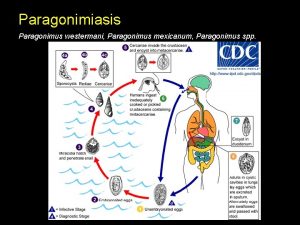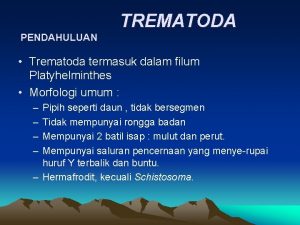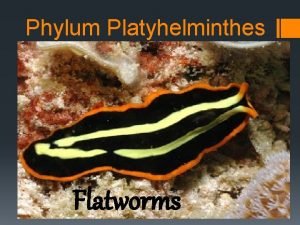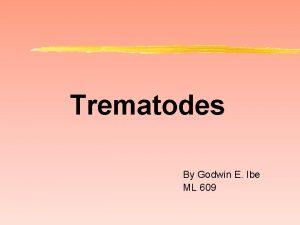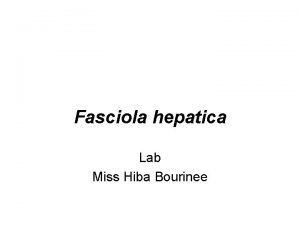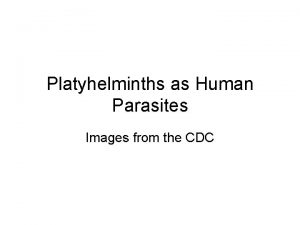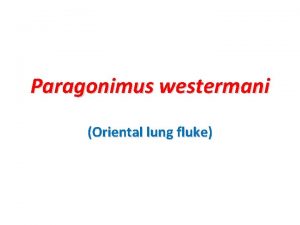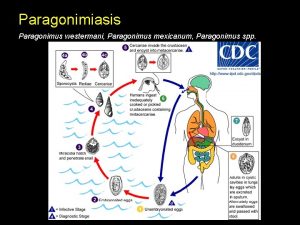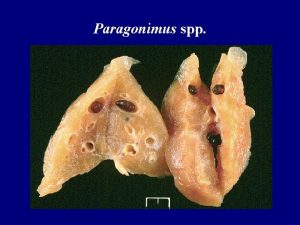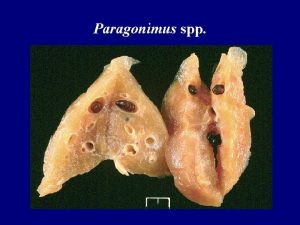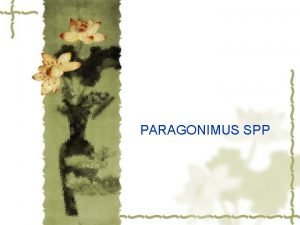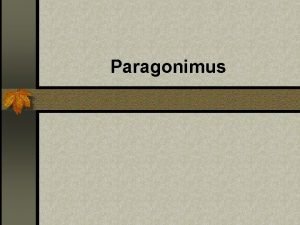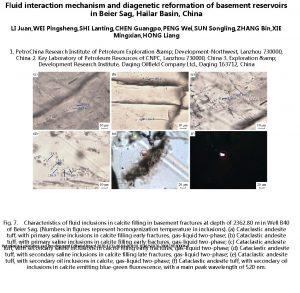Paragonimus westermani PARAGONIMUS WESTERMANI Diagenetic Trematode Infects the

















- Slides: 17

Paragonimus westermani

PARAGONIMUS WESTERMANI • • Diagenetic Trematode Infects the lungs of definitive host (humans) Discovered in 1877 Found mainly in Asia Life span usually 6 years but can live up to 20 years Most common oriental lung fluke to infect humans Genus includes 45 species of lung fluke Only 12 species infect man – Paragonimus africanus (West Africa) – Paragonimus mexicanus (Central America)

Morphology Trematode (fluke) means pierced with holes 1) Characterized by oral and ventral suckers 2) Oval shape 8 -16 mm by 4 -8 mm 3) Bodies unsegmented 4) Alimentary canal incomplete 5) Excretory system is bilaterally symmetric 6) Reciprocally inseminating simultaneous hermaphrodite

Life Cycle Diagenetic means alterations of generations 1) Two intermediate hosts and one human definitive host 2) Polyembryony Eggs Miracidia First intermediate host Sporocyst (Melania snail) Redia Daughter Redia Raw crab Metacercaria Crustacean Cercaria


Transmission By eating inadequately cooked or pickled food Crustaceans (crabs and crayfish) containing metacercaria Wild boar (paratenic host) harboring juvenile P. westermani

Factors that facilitate transmission I. Behavior spitting and using human feces as fertilizer II. Wetland environments

III. Culinary habits of culture - China and Philippines “Drunken crab” 1. marinated raw crab in rice wine, soy sauce, and spring onions 2. Leave over night and enjoy the next day - Korea “Gye muchim” (seasoned raw crab) - Japan “Ama ebi” (sushi crab) Drunken crab


Pathogenic Effects • Zoonotic disease • Infection route by mouth • • Invading and migration stage – Excystation then adolescents penetrate intestinal wall and migrate to lungs Suppurative stage – Neutrophils and eosinophils surround worms and form abscess Cystic stage – Cyst wall is formed and hemoptysis results (the coughing up of rusty sputum containing blood and eggs) Fibrous-scar stage – Worm dead and pus is expelled leaving fibrous-scar tissue

Clinical Manifestation • Two phases of paragonimiasis • Acute phase • Abdominal type – Abdominal pain, diarrhea, and mucus of ova in feces • Subcutaneous type – Painless subcutaneous nodules • Chronic phase • Pulmonary type – Resemble tuberculosis, low fever, hemoptysis, and chest pain – Rarely fatal even without treatment flukes eventually die in 10 to 20 years • Brain type – Epilepsy, visual disturbance, aphasia – 5% die form hemorrhage

Diagnosis 1) Sputum or stool examination for ova, eggs may not be present for 2 -3 months 2) CT of brain 3) X-ray of the lungs 4) Blood tests for neutrophils and eosinophils Treatment Praziquantel 1) Increase cell membrane permeability in fluke 2) Results in loss of calcium, massive contractions, and paralysis 3) Attachment of phagocytes to fluke 4) Side effects are mild drowsiness and headache 5) Eggs clear from sputum in a few weeks 6) Cure almost 100% except in case of cerebral damage

X-ray of infected lung

Prevention 1) Properly cook crab and crayfish 2) Avoid sputum and feces getting into water 3) Molluscicides at present are impractical

Incidence and Distribution Geographic distribution 1) Endemic in Japan, Taiwan, central China, India, Philippines, and Korea 2) Found in Malaysia, Indonesia, and Thailand Incidence 1) In endemic areas infection ranges form 1 in 1000 to 1 in 4 a. Manipar India 8% infection in people who eat raw crab b. Ulchin Korea 13. 9% of school children positive reaction 2) 21 million people infected 3) 200 million at risk a.

Distribution map of P. westermani in Asia

Interested in More • http: //www. atlas. or. kr/index. html • http: //pathmicro. med. sc. edu/parasitology/trematodes. htm • http: //www. cdc. gov
 Paragonimus westermani
Paragonimus westermani Huevo de paragonimus
Huevo de paragonimus Termasuk dalam filum
Termasuk dalam filum Paragonimus westermani second intermediate host
Paragonimus westermani second intermediate host Paragonimus
Paragonimus Trematode life cycle
Trematode life cycle F buski
F buski Paragonimus sp
Paragonimus sp Paragonimus
Paragonimus Cách giải mật thư tọa độ
Cách giải mật thư tọa độ Bổ thể
Bổ thể Tư thế ngồi viết
Tư thế ngồi viết ưu thế lai là gì
ưu thế lai là gì Thẻ vin
Thẻ vin Thể thơ truyền thống
Thể thơ truyền thống Các châu lục và đại dương trên thế giới
Các châu lục và đại dương trên thế giới Từ ngữ thể hiện lòng nhân hậu
Từ ngữ thể hiện lòng nhân hậu Diễn thế sinh thái là
Diễn thế sinh thái là

